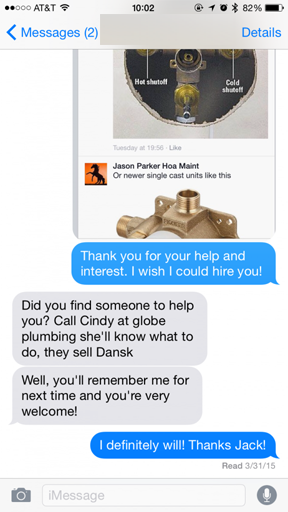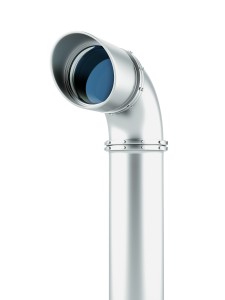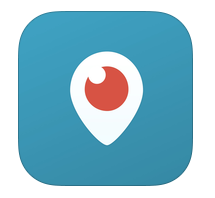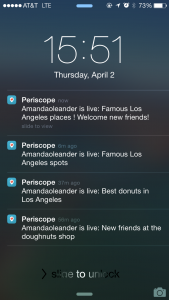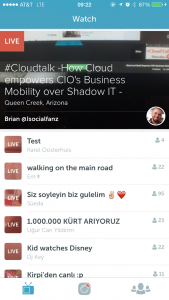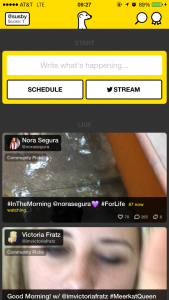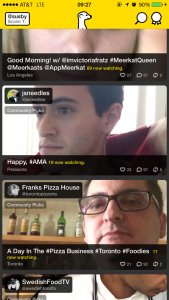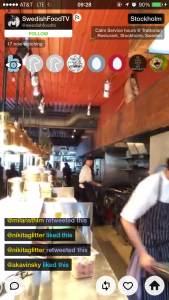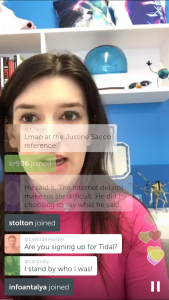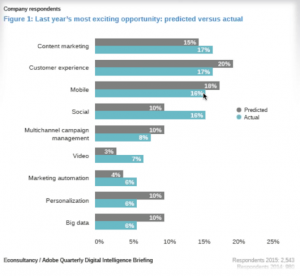What is Periscope and Why Should I Care?
The live streaming app Periscope was recently acquired by Twitter. In this post, we’ll look at why Periscope and competitor live streaming app, Meerkat as well as other similar mobile broadcasting solutions. We’ll also describe why these live streaming apps will be game changers in social media marketing as well as citizen journalism.
Periscope is a brand new live streaming app. What does that mean? It means it’s mobile, i.e. it’s on your phone, with you all the time, so you as a Periscope app owner/user can live stream video of anything anywhere as long as you have a connection to the Internet. It’s difficult to grasp the nature of the app until you actually use it. Because it is video, it requires real-time immersion to actually see first hand how it works. Without this real life experience, it would be similar to you trying to understand Facebook without having any friends on it.
We Are the Media
If you understand that Twitter connects people all around the world, enabling conversations around niche interests, then you’ll start to be able to imagine a world where those conversations are not just text and tweets. Now they can be based on the viewing of a live event, whether that be a protest like the #Egypt revolution, sports event like the USA basketball #marchMadness or #FIFA, the world cup soccer, or even less newsy, but still interesting adventures like your personal commute to work in London, or how to make a cesar salad at a steakhouse in New York as Dave Kerpen showed a few days ago.
When someone starts streaming you get alerts on your phone. @Amandaoleander is a prolific broadcaster and has already achieved a million hearts. Hearts on Periscope are like favorites in Twitter.
The above screenshot shows an example of a Meerkat alert when you are following a broadcaster.
Upon entering Periscope you see a list of videos that are currently live.
There is also a list of recently aired videos.
Meerkat having been around about a month longer than Periscope uses the “Write what’s happening…” prompt to encourage you to title your live video or schedule one for posting later.
Videos in Meerkat show in a still in preview mode.
When Meerkat videos are running, you see the avatars of everyone who is watching, you have the ability to comment, heart (favorite or like) and retweet or share the video.
On Periscope, there is just the ability to comment and touching the screen produces a heart which floats above the video and fades out.
If you understand the benefits and ubiquity of YouTube, combine that will no need to edit your video and the ability to stream live conversations in an instant from your mobile device, and you start to be able to imagine how this may change the way we consume all broadcast media. No longer are just the big Television stations able to broadcast, but you can now too!
Connecting People
Right now you can tweet to your favorite celebrity and they may indeed reply to your tweet. You can also have conversations with your fellow fans of TV shows, sports team and rock stars. How much more connected would you feel and fun would it be to have one of these celebrities live streaming a Q&A and/or showing a behind the scenes view of the locker room before a game, green room before a concert and/or just someone getting ready to watch the TV show they created with the fans that love it? Imagine Shonda Rhymes broadcasting a Q&A session during the most recent episode of Scandal. Right now the conversation happens on Twitter, but it could just as easily happen on Periscope helping fans feel more personally connected to Shonda.
Periscope is currently in an experimentation mode, since it was just launched about a week ago (and launched between Alpha and Beta phases). This means that most people and companies using it are still trying to figure best practices and original ideas. There are going to be a lot of people that don’t understand the potential impact live streaming will have, because of all the early experimentation (and pardon my bluntness, crap) that’s being posted. Just like people poo-poohed Twitter saying that it was just a bunch of people talking about what they had for lunch, Periscope and Meerkat will have and are having a similar pushback right now.
But from what I can see after just a few days of the launch of Periscope, the adoption among tech and digital marketing industry zealots and professionals means it is a phenomenon to be monitored. Early adopters are always first to play and experiment with new technology. Yes, most of what we see being shared on Periscope could be construed as meaningless, but remember, especially in the social media marketing and app industries, playing is learning.
Just as Facebook and Twitter introduced us to social media and changed the way we think about marketing, connecting and buzz, Periscope and Meerkat will provide a whole new lens into how we communicate. As Brian Solis said: “Participation is marketing.” Periscope is a new channel upon which we now have the ability to share real-time events and life happenings in an instant, easily enabling people to connect and share feedback as well. Live streaming is the next big thing in social.
An Arrangement of Lenses
The dictionary.com definition of periscope describes a periscope as an “optical instrument…with an arrangement of lenses”:
“Noun.
an optical instrument for viewing objects that are above the level of
direct sight or in an otherwise obstructed field of vision, consisting
essentially of a tube with an arrangement of prisms or mirrors
and, usually, lenses: used especially in submarines.”
I like to think of the lenses (like Squidoo) in the Periscope app as opinions coming from viewers and also the broadcaster. Never before has broadcasting been so easy! If we think back to before point and shoot film cameras and then digital photography, there were only a select few who could capture a still image. Today everyone can capture any image and distribute it worldwide within seconds. Not only that, but now the ability to share your own opinion, an event, tips and anything you might find interesting via live streaming video from your phone to a network of friends and strangers.
Which one is better, Periscope or Meerkat?
Both platforms are still in their infancy and there are lots of wish list features for each. I see huge potential for live streaming to be a game changer in social media marketing as well as general peer communications. What Periscope lacks in search and distribution on the Twitter platform, it makes up for with constant alerts of live broadcasts being made available, and ease of use.
The fact that you can’t search on Periscope for a certain topic, means you are at the mercy of everyone on the platform and who you’ve chosen to follow. Since the first set of people you’re following is pulled from Twitter though, it’s likely you’ll find a few interesting people broadcasting on topics that are engaging.
Since Meerkat allows share of the Meerkat broadcast on Twitter, people are more apt to view it after the fact, but hopefully Periscope will figure out how to show broadcasts on Twitter in the Twitter stream like it does with Vine for example.
It may be called a fad for a while, but this is the kind of new technology that people doubt before it becomes the norm. Facebook and Twitter were frowned upon for years before they became mainstream social networks. I predict Periscope and Meerkat will have similar growth.
The technology has been around for a while says Mashable’s Ben Parr on an interview with NBC news via Periscope today. Justin.TV was purchased by Twitch. We had Ustream and others several years ago, but never before has it been so easy to live stream. This is the result of increased bandwidth and enhanced video capabilities in smart phones. “It’s not a replacement for the traditional media model,” say Parr, but it does facilitate more people being able to share what is going on in the world around them at any given moment. This has implications for citizen journalism and with the likes of companies like OnPublico who facilitate people sharing local news as well as personal expertise and just plain fun.
Ben Parr live streaming on Periscope in an interview about Periscope with NBC today.
What About Those Trolls?
Yes, there are a lot of trolls on both Meerkat and Periscope, but since Periscope is the newer platform and seemingly easier to use, there seem to be more on Periscope. The platform is still working out the kinks, but we already see ways to block spammers and trolls.
Finally as with anything Internet, there is likely to be a lot of unsavory content (think porn) on the platform since that’s what being able to both hide behind the screen and flaunt your wears facilitates.
Be careful who or what you’re watching and be aware of trolls, but my advice to anyone wanting to share a story, breaking news, event or skill in real time is definitely to try a live streaming and/or citizen journalism app. And definitely have them available to you incase you find yourself being the first to report a story.
We used to say “News doesn’t break, it tweets.” Will we soon be saying “News doesn’t break, it’s live streaming now”?
Best Practices for live streaming:
- Acknowledge and thank people who have joined your live feed to watch. Actually say thank you while you are recording your video. People love to hear the sound of their own name and when it is being broadcast live, it sounds even better.
- Ask questions of your audience and respond to them. Remember that this is another opportunity to build a community around your specific topic of interest. Start a conversation.
- Be useful and helpful. Remember Jay Baer‘s “Help Not Hype” mantra.
- Offer ways for people to share and participate in the conversation. Ask people to share and tweet the video either during (easiest on Meerkat) or after the broadcast is complete.
- Keep your content tasteful and valuable. Remember that content is always going to be king, frequency is queen and entertainment is the jack of all parades!
- Make sure you have something worth watching. A little planning before you start broadcasting could go a long way. Think about how you are going to appear, where the camera will be and what you are going to say.
- Have a catchy headline/title for your video. Headlines still rule and your hook must still hook.
What kinds of things are working for you on Periscope or Meerkat? What are your favorite things to watch? Who are your top broadcasters? Do you think live streaming will change the way we interact with the world? Please include your thoughts in the comments below.
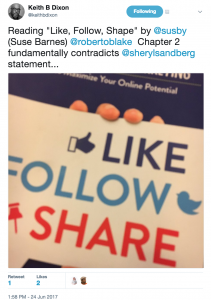
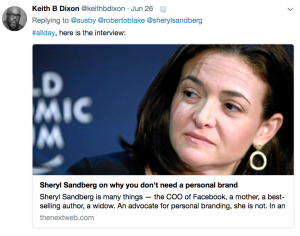 she likes it or not, means she has a brand.
she likes it or not, means she has a brand.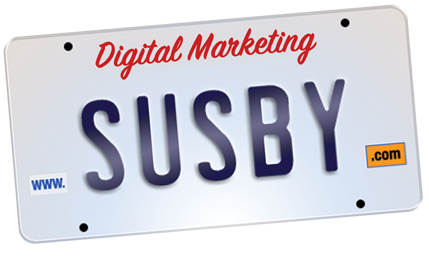
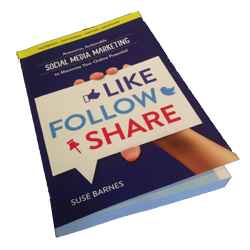
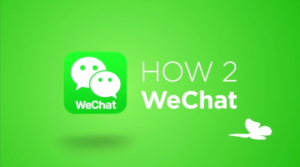 Many of you many already feel very comfortable using the big social networks that dominate the U.S. market, but have you ever thought about social networking in other countries? You may have heard of a WeChat? It’s a social network dominant in China. Have you ever wondered how it works? One of my very smart and talented students,
Many of you many already feel very comfortable using the big social networks that dominate the U.S. market, but have you ever thought about social networking in other countries? You may have heard of a WeChat? It’s a social network dominant in China. Have you ever wondered how it works? One of my very smart and talented students, 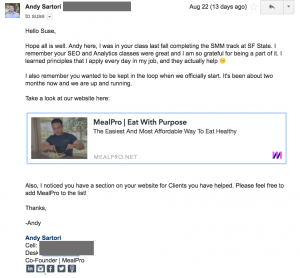
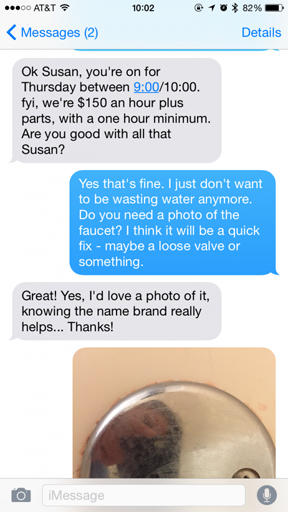 2
2 
 4
4 